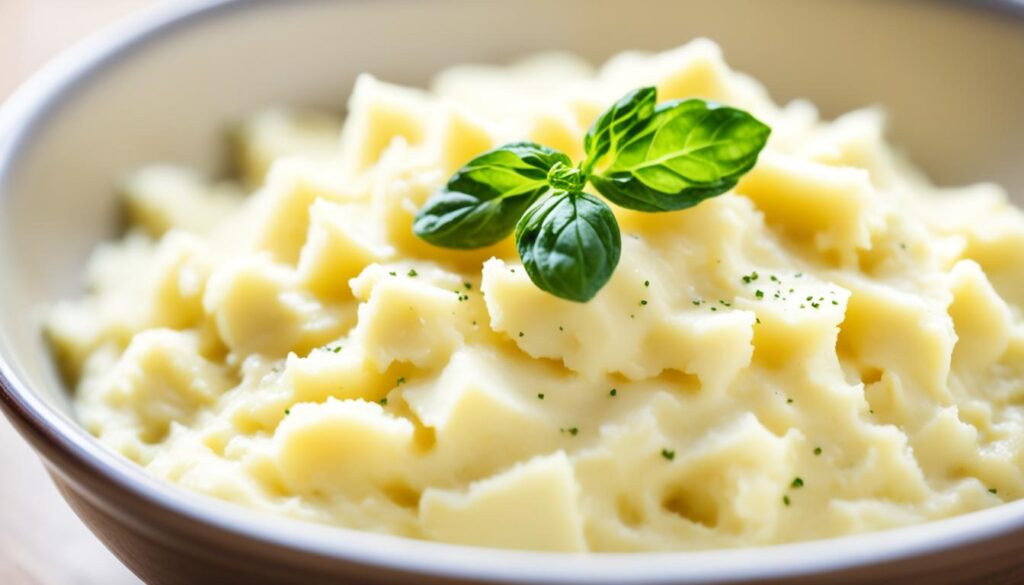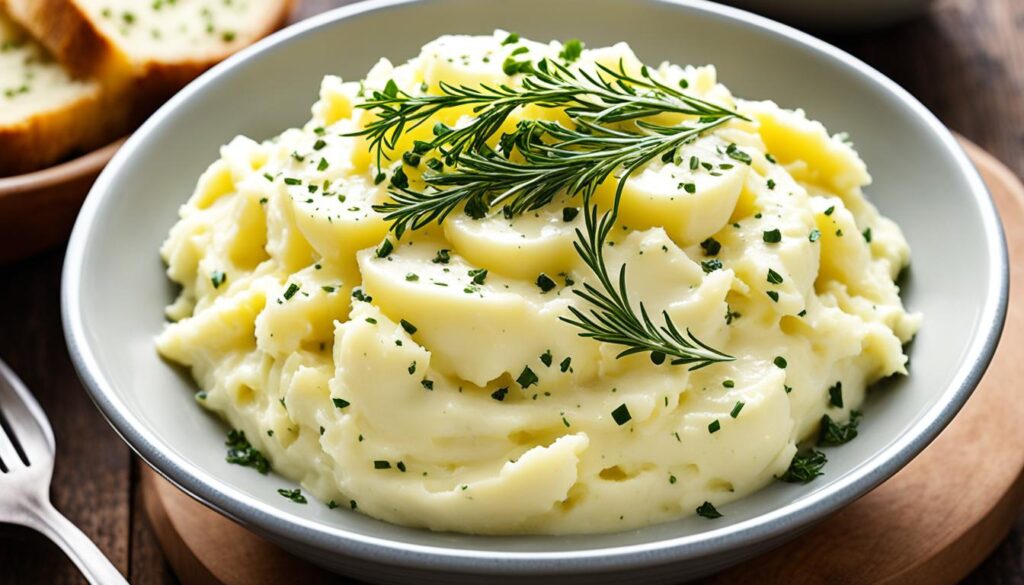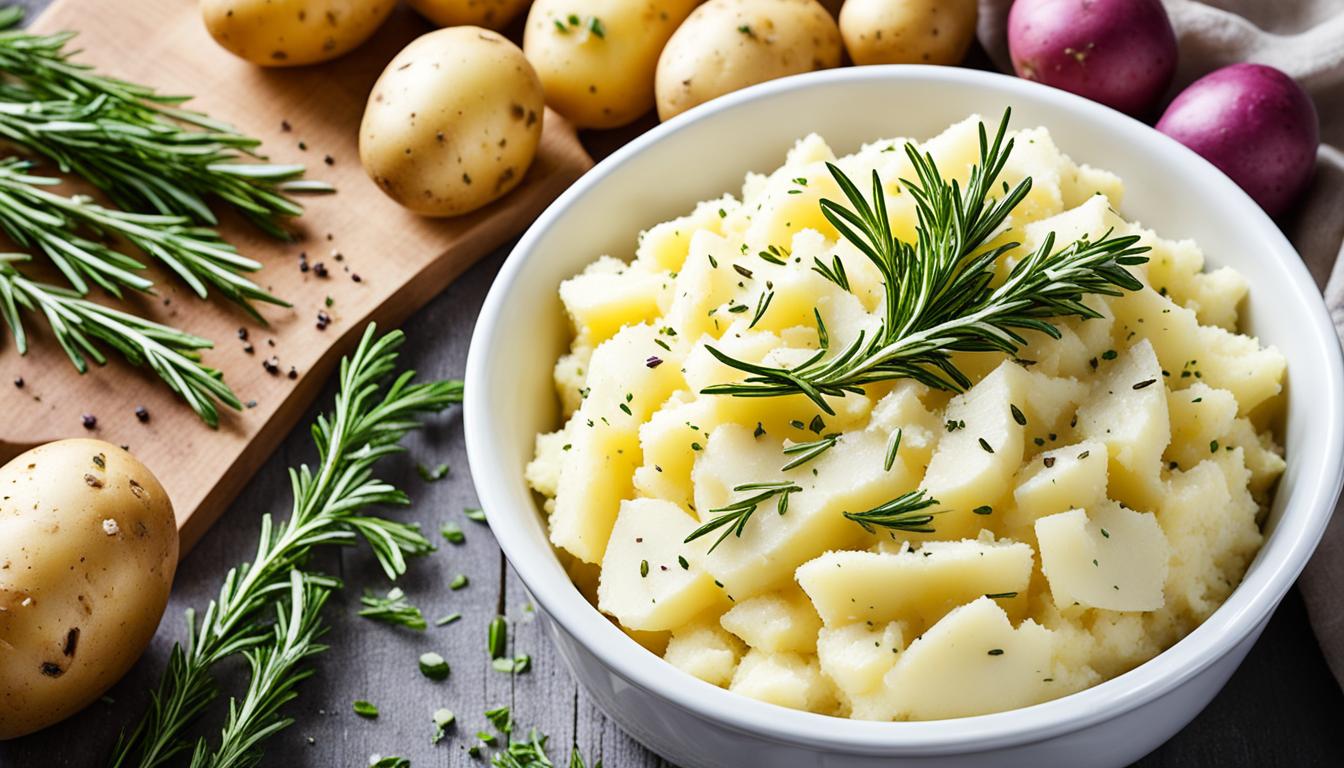Mashed potatoes are the ultimate winter comfort food, but achieving the perfect texture can be tricky. In order to create a mash made in heaven, there are several key tips to keep in mind. These tips include selecting the right potato variety, avoiding lumps, and serving with delicious dishes. By following these tips, you can elevate your mashed potatoes to new levels of creaminess and flavor.
Key Takeaways:
- Choosing the right potato variety is essential for the perfect texture and taste of mashed potatoes.
- Avoiding lumps is crucial for achieving smooth and creamy mashed potatoes.
- Serving mashed potatoes with delicious accompaniments can enhance the overall flavor.
- Avoid common mistakes such as cutting potatoes too small or overworking them.
- Learn how to rescue soupy or gluey mashed potatoes with simple fixes.
Are you ready to take your mashed potatoes to the next level? Discover the secrets to achieving the creamiest and most flavorful mash made in heaven. Whether you’re a novice or a seasoned cook, these expert tips will transform your mashed potatoes into a culinary masterpiece. So, let’s dive in and unveil the secrets behind better mashed potatoes!
Selecting the Best Potato Variety
The type of potato you choose can greatly impact the texture and taste of your mashed potatoes. When it comes to selecting the best potato variety for mashing, two top choices are King Edward and Marfona potatoes. These varieties have a high starch content, which results in a fluffy and light texture when mashed.
King Edward Potatoes
King Edward potatoes are a popular choice for mashing due to their creamy texture and rich flavor. These potatoes have a floury texture and break down easily when cooked, resulting in smooth and lump-free mashed potatoes. They are versatile and can be used for both classic mashed potatoes and other variations like cheesy mash.
Marfona Potatoes
Marfona potatoes are another excellent option for making mashed potatoes. These potatoes are known for their waxy texture and rich, buttery taste. They provide a creamy yet slightly firm texture when mashed, creating a satisfying mouthfeel. Marfona potatoes are particularly well-suited for making fluffy and light mashed potatoes.
While King Edward and Marfona are highly recommended for traditional mashed potatoes, other varieties like King Edward or Desiree potatoes can be used for cheesy mash, and Maris Piper potatoes are great for cabbage mash. Don’t hesitate to experiment with different potato varieties to discover your preferred flavor and texture.
Eliminating Lumps in Your Mash
To achieve ultra-smooth mashed potatoes, it’s important to eliminate lumps. Here are the steps to follow:
- Start by cutting the potatoes into medium-sized chunks and washing them well in cold water.
- Boil the potatoes until they are fully cooked but not falling apart.
- Drain the potatoes well and steam them over low heat to remove excess moisture.
- Mash the potatoes using a potato masher or mouli until they are fully broken down.
- To avoid lumps, add melted butter, warmed milk, salt, pepper, and any additional seasonings.
Beat the mixture gently until it becomes light and fluffy.
By meticulously following these steps, you will achieve mashed potatoes with a smooth and creamy texture, free of any unsightly lumps.
Expert Tip:
“To ensure lump-free mashed potatoes, it’s important to start with well-cooked potatoes and gradually incorporate the butter and milk while beating the mixture gently. Adding small amounts of liquid at a time while mashing will help achieve the desired consistency.”

| Common Mistakes to Avoid | How to Eliminate Lumps |
|---|---|
| Cutting potatoes too small, leading to a soupy texture | Cut potatoes into medium-sized chunks for better texture |
| Adding all dairy ingredients at once, resulting in gluey mash | Gradually add melted butter and warmed milk while beating gently |
| Overworking the potatoes, resulting in a pasty texture | Mash potatoes until fully broken down, but avoid excessive mashing |
Serving Three Delicious Mashed Potato Dishes
In addition to mastering the technique of mashed potatoes, serving them with delicious accompaniments can take them to the next level. There are three mouthwatering recipes to try: Classic Mash, Cheesy Mash, and Cabbage Mash.
Classic Mash
Served with sausages and onion gravy
Ingredients:
- 4 large potatoes
- 2 tablespoons butter
- 1/4 cup milk
- Salt and pepper to taste
- Sausages
- Onion gravy
To make Classic Mash, peel and boil the potatoes until tender. Drain well and return to the pot. Add the butter and milk, then mash until smooth and creamy. Season with salt and pepper to taste. Serve the Classic Mash alongside grilled or pan-fried sausages, and drizzle with rich onion gravy.
Cheesy Mash
Pairs well with steamed or fried fish, or roast chicken breasts
Ingredients:
- 4 large potatoes
- 2 tablespoons butter
- 1/4 cup milk
- Salt and pepper to taste
- 1 cup shredded cheese (cheddar, Gruyere, or your choice)
To make Cheesy Mash, follow the same steps as Classic Mash, but add shredded cheese to the mashed potatoes while they are still warm. Mix well until the cheese is melted and evenly distributed. This rich and flavorful Cheesy Mash pairs perfectly with steamed or fried fish, or juicy roast chicken breasts.
Cabbage Mash
Perfect side dish for grilled pork chops, lamb cutlets, or poached or fried eggs
Ingredients:
- 4 large potatoes
- 2 tablespoons butter
- 1/4 cup milk
- Salt and pepper to taste
- 1 cup finely shredded cabbage
To make Cabbage Mash, prepare the mashed potatoes as you would for Classic Mash. In a separate pan, sauté the shredded cabbage in butter until tender. Fold the cabbage into the mashed potatoes, mixing well to incorporate the flavors. Serve this flavorful Cabbage Mash as a delightful side dish alongside grilled pork chops, succulent lamb cutlets, or perfectly poached or fried eggs.

By exploring these three delectable mashed potato recipes, you can elevate your dining experience and delight your taste buds. Classic Mash, Cheesy Mash, and Cabbage Mash offer a delightful variety of flavors and pairings, ensuring there’s a mashed potato dish for every occasion. So, why settle for plain mashed potatoes when you can enjoy these mouthwatering creations?
Common Mistakes to Avoid
When it comes to making mashed potatoes, there are a few common mistakes that can hinder your success. By being aware of these pitfalls, you can ensure that your mashed potatoes turn out perfectly every time.
Mistake: Cutting the potatoes too small
Cutting the potatoes into tiny pieces may seem like a time-saving option, but it can lead to water-logged mashed potatoes with a soupy texture. When the potatoes are cut too small, they absorb more water during the cooking process, resulting in a less desirable consistency. To avoid this, aim for evenly-sized medium chunks of potatoes for mashing.
Mistake: Adding all dairy ingredients at once
It’s tempting to dump all the dairy ingredients, such as butter and milk, into the pot together. However, doing so can cause the mashed potatoes to become gluey and heavy. To prevent this, add the dairy ingredients gradually, starting with a smaller amount, and mix them in gently until you achieve the desired consistency.
Mistake: Overworking the potatoes
One of the biggest mistakes when mashing potatoes is overworking them. Excessive mashing can lead to the release of excess starch, resulting in a dense and pasty texture. Instead, mash the potatoes just until they are broken down and mixed with the other ingredients. Stop as soon as the desired consistency is achieved, and avoid any further excessive mixing or beating.
By avoiding these common mistakes, you can ensure that your mashed potatoes are fluffy, creamy, and absolutely delicious.
Quick Summary:
- Cut the potatoes into medium-sized chunks to avoid a soupy texture.
- Add dairy ingredients gradually to prevent gluey and heavy mashed potatoes.
- Avoid overworking the potatoes to maintain a light and fluffy consistency.
Rescuing Soupy Mashed Potatoes
If you end up with soupy mashed potatoes, there are a few ways to rescue them. Don’t worry; we’ve got you covered! Follow these thickening tips to salvage your runny mash:
- Cook Extra Potatoes:
If your mashed potatoes are too watery, cook a few extra potatoes separately. Rice them and fold them into the loose batch of mashed potatoes. The extra potatoes will help absorb the excess liquid and thicken the mixture.
- Add Instant Mashed Potatoes:
If you have instant mashed potatoes on hand, they can be a quick fix for runny mashed potatoes. Add small amounts of instant mashed potatoes to your loose batch and mix thoroughly. The instant mashed potatoes will absorb the excess liquid and help bind the mixture together.
- Whisk in Starches:
To thicken your soupy mashed potatoes, whisk in starches like cornstarch, tapioca starch, or potato starch. Start by adding a small amount and gradually increase until you achieve the desired thickness. Whisking in the starches will help absorb the excess liquid and create a thicker consistency.
Remember, when using starches, add them gradually to avoid over-thickening the potatoes. You want to achieve a smooth and creamy consistency without making them too dense.
Rescuing Soupy Mashed Potatoes Table
| Methods | Description |
|---|---|
| Cook Extra Potatoes | Cook and rice a few extra potatoes, then fold them into the loose batch to thicken it up. |
| Add Instant Mashed Potatoes | Use instant mashed potatoes to absorb excess liquid and bind the mixture together. |
| Whisk in Starches | Whisk in cornstarch, tapioca starch, or potato starch to thicken the mashed potatoes gradually. |
Dealing with Gluey Mashed Potatoes
Gluey mashed potatoes can be a disappointment, but there are ways to prevent and address this issue. When too much potato starch is released during the mashing process, the result is a dense and pasty texture. To avoid gluey mashed potatoes, follow these helpful tips:
1. Rinse the Potatoes
Before and after cooking the potatoes, be sure to rinse them well with cold water. This will help remove excess starch, which can contribute to a sticky texture. Give the potatoes a thorough rinse to ensure the best results.
2. Be Gentle when Mashing
When mashing the potatoes, be mindful of the amount of force you apply. Being too aggressive can lead to the release of excessive starch, resulting in a gluey consistency. Instead, use a gentle hand and avoid over-mashing.
3. Consider Using a Potato Ricer or Food Mill
A potato ricer or food mill can be excellent tools for achieving light and airy mashed potatoes. These tools help break down the potatoes without overworking them, resulting in a smoother texture. Consider incorporating a potato ricer or food mill into your mashing process for optimal results.
“Using these techniques will help you avoid the disappointment of gluey mashed potatoes and ensure a smooth and delightful texture.”
If you’ve already incorporated too much starch and ended up with gluey mashed potatoes, unfortunately, there is no way to fix this issue. It’s best to start over or repurpose the potatoes into a different dish, such as pommes aligot.
| Common Causes of Gluey Mashed Potatoes | Prevention |
|---|---|
| Potato starch release during mashing | Rinse potatoes before and after cooking |
| Aggressive mashing | Be gentle and avoid over-mashing |
| Excessive starch incorporation | Consider using a potato ricer or food mill |
Make-Ahead and Reheating Tips
When it comes to mashed potatoes, preparation is key. By making them ahead of time, you can save precious minutes on busy days and still serve up a piping hot bowl of creamy goodness. Here are some handy tips for making and reheating mashed potatoes.
Make-Ahead Mashed Potatoes
Making mashed potatoes in advance is a convenient way to cut down on prep time. Follow these steps:
- Prepare your mashed potatoes as usual, using your favorite recipe.
- Allow the mashed potatoes to cool completely.
- Transfer the mashed potatoes to an airtight container or a covered casserole dish.
- Store in the refrigerator for up to 48 hours.
When you’re ready to serve your make-ahead mashed potatoes, there are a few different ways to reheat them:
- Warm them up in the oven: Preheat the oven to 350°F (175°C). Place the mashed potatoes in a covered casserole dish and bake for 20-30 minutes or until heated through. Stir occasionally to ensure even heat distribution.
- Create a mashed potato casserole: Transfer the mashed potatoes to a greased baking dish. Top with breadcrumbs and a sprinkle of cheese. Bake at 375°F (190°C) for 25-30 minutes or until the top is golden and crispy.
- Hold off on adding the milk until reheating: When making the mashed potatoes, omit the milk. Instead, add it right before reheating. This helps to maintain a creamy consistency.
- Use a sous vide water bath: If you have a sous vide machine, transfer the mashed potatoes to a vacuum-sealed bag. Heat a pot of water to 140°F (60°C) using the sous vide machine and place the bag of mashed potatoes in the water for 30-45 minutes until heated through.
These methods ensure that you can serve hot mashed potatoes without stress or last-minute preparation.
Mashed Potato Reheating Tips
If you have leftovers or want to reheat mashed potatoes that were already served, here are a couple of tips:
- Stovetop reheating: Transfer the mashed potatoes to a saucepan and heat over medium-low heat. Stir frequently to prevent sticking and heat until warmed through.
- Microwave reheating: Place the mashed potatoes in a microwave-safe dish and microwave on high for 1-2 minutes. Stir every 30 seconds to ensure even heating.
Remember to add a splash of milk or cream and a knob of butter to revive the creamy texture of reheated mashed potatoes.
With these make-ahead and reheating tips, you can enjoy delicious mashed potatoes any day of the week, whether it’s a special occasion or a quick weeknight dinner.
Alternatives When Things Go Wrong
In case things go wrong and you’re unable to fix or reheat homemade mashed potatoes, there are alternatives available. These options provide a backup plan for those unexpected situations:
1. Supermarket Mashed Potatoes
If you find yourself in a pinch, many supermarkets offer prepared mashed potatoes in their food sections. While they may not have the same homemade taste, they can be doctored up with additional ingredients to enhance the flavor. Some suggestions include:
- Adding a dollop of sour cream for tanginess
- Mixing in shredded cheese for extra creaminess
- Sprinkling herbs like chives or parsley for added freshness
- Seasoning with garlic powder or onion powder for more flavor
With a few simple additions, supermarket mashed potatoes can be transformed into a tasty side dish.
2. Instant Mashed Potatoes
An even more convenient and reliable option is using instant mashed potatoes. These are quick to prepare and can save the day when you’re in a time crunch. To make instant mashed potatoes, simply follow the instructions on the packaging, which typically involve boiling water and adding the potato flakes. Instant mashed potatoes can be customized by adding butter, milk, and seasonings to taste. While they may not have the same texture as homemade mashed potatoes, they offer a quick and easy alternative.
When using either supermarket mashed potatoes or instant mashed potatoes, keep in mind that they may not have the same depth of flavor or texture as homemade mashed potatoes. However, in a pinch, they can be a convenient solution that still satisfies your craving for creamy and comforting mashed potatoes.
| Supermarket Mashed Potatoes | Instant Mashed Potatoes |
|---|---|
| Convenient option | Quick and easy to prepare |
| Doctored up with additional ingredients | Customizable with butter, milk, and seasonings |
| May lack homemade taste | May not have the same texture as homemade |
| Can be transformed into a tasty side dish | Still satisfies the craving for mashed potatoes |
Conclusion
Mashed potatoes are a beloved comfort food that can be enjoyed all year round. By following the tips and techniques mentioned in this article, you can create mashed potatoes that are creamy, fluffy, and full of flavor. From selecting the right potato variety to avoiding common mistakes, each step contributes to the success of your mashed potatoes. Whether you’re serving classic mash, cheesy mash, or cabbage mash, these tips will help you achieve mashed potato perfection every time.
Remember to choose the best potato variety for the desired texture and taste. King Edward and Marfona potatoes are recommended for a fluffy and light texture. Eliminate lumps by washing and cooking the potatoes properly, and use a potato masher or mouli to achieve a smooth consistency. Serve your mashed potatoes with delicious accompaniments like sausages and onion gravy, fish, or roasted chicken to enhance the overall flavor.
When making mashed potatoes, it’s important to avoid common mistakes such as cutting the potatoes too small or adding all the dairy ingredients at once. If you end up with soupy mashed potatoes, there are ways to rescue them by adding cooked potatoes, instant mashed potatoes, or starches like cornstarch or tapioca starch. On the other hand, if your mashed potatoes turn out gluey, rinsing the potatoes before and after cooking can help prevent excessive starch release. If the excess starch is already incorporated, it’s best to start over or repurpose the potatoes into a different dish.
Lastly, mashed potatoes can be made ahead of time and reheated when needed. Store whipped potatoes in the refrigerator and use methods like making a mashed potato casserole or using a sous vide water bath to keep them warm and ready to serve. In case homemade mashed potatoes don’t turn out as expected or you’re short on time, supermarket prepared mashed potatoes or instant mashed potatoes can serve as convenient alternatives.
